Today's Post in <50 Words: I continue sharing documents from the Don Ephlin library archive. What did Ford and the UAW learn when they visited Japan in 1981? Many of the things that made Japanese industry successful are the same things that make organizations successful with Lean today, including in healthcare.
I grew up around Detroit. I started my career at General Motors in 1995 after two summer internships at Ford.
I'm fascinated by the history of the auto industry in the 1980s and 1990s, the era when pride, poor quality, and slow change caught up to them, hence my interest in the book Comeback and my podcasts with Steve Bera.
During the 1980s, many in the Detroit auto industry were in denial about the Japanese competitive threat, led by Toyota. Many thought they were beneficiaries of currency manipulation and other favorable government treatment.
Many didn't know (or were in denial) that the Japanese had a different way of leading… what we'd now know as “The Toyota Production System,” “The Toyota Way” (as codified in 2001), or “Lean.”
Listen to today's post (subscribe to the podcast):
When I visited the papers of Don Ephlin, one of the documents I found was a trip report from when a delegation of Ford and UAW leaders visited Japan in 1981. Ephlin was the lead Ford representative for the union.
Here is the cover of the 1981 report on “Japanese Automotive and Related Industries.”
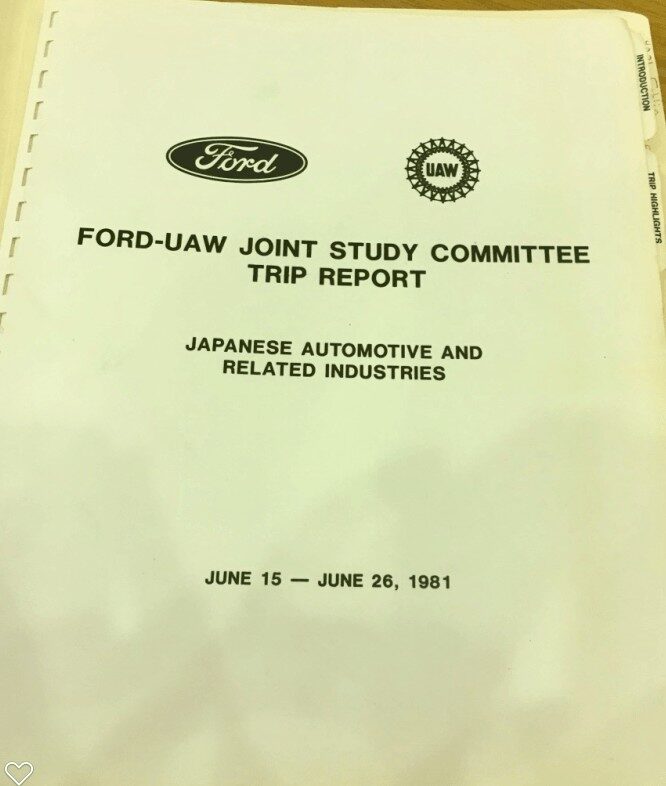
What was the purpose of the trip? To learn so they could better compete in the auto industry. It was a “joint” activity, meaning the automaker and union were in partnership.
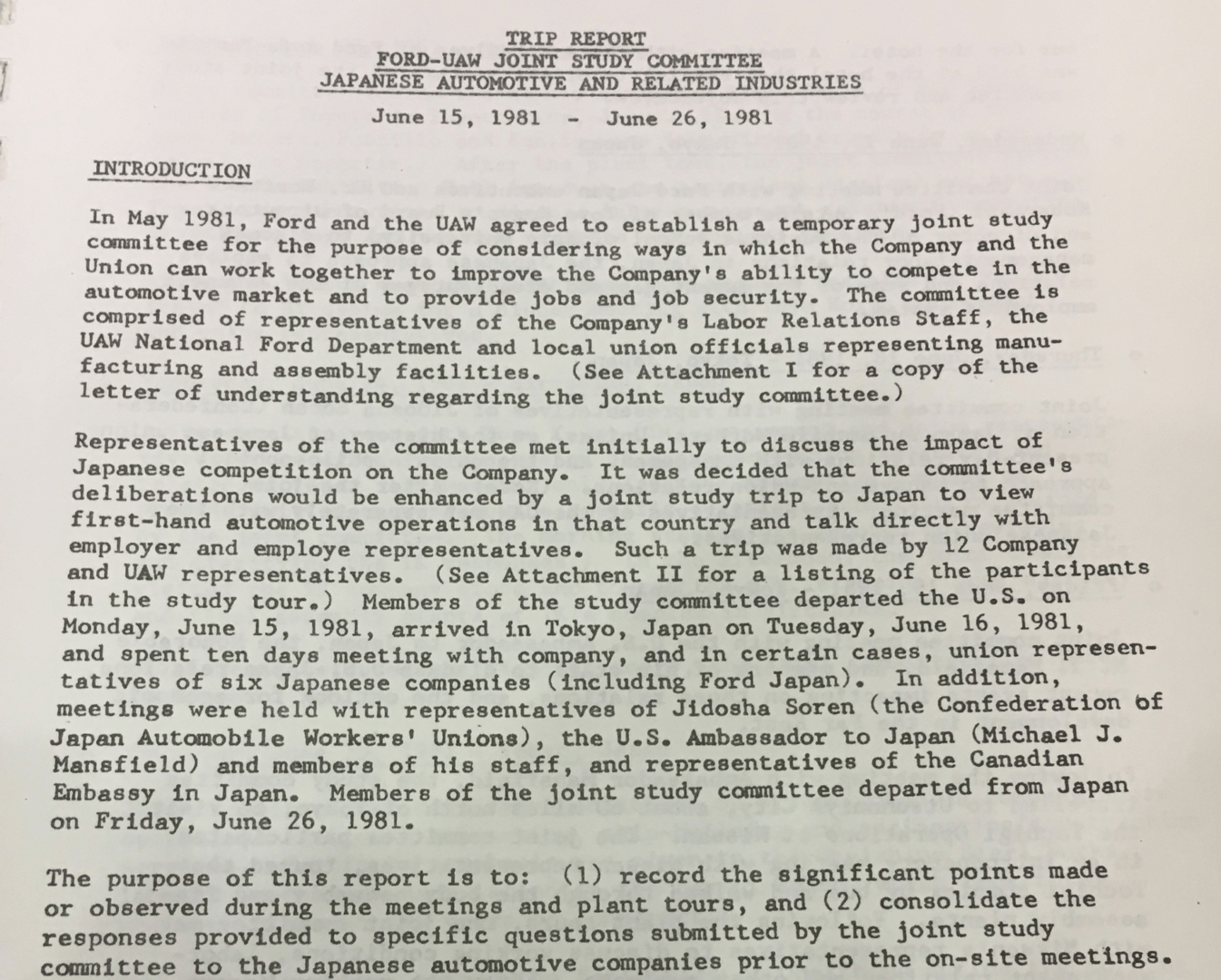
The itinerary included:
- Press conferences and media appearances
- Touring “plant number 9” of the Kamigo Toyota complex in Toyota City (it opened in 1965 and is still producing engines today)
- Meeting with Toyota union representatives to talk about “labor-management relations, operating practices, wages and related payments and employee benefits”
- Visiting Toyo Kogyo (the name of Mazda's parent company)
- Visiting Nippon Kokan (NKK) – steel making, ship building, etc.
- Other governmental meetings, including the Canadian embassy
Dr. Noritake Kobayashi Talk Notes
The document summarizes their observations, including highlights from a talk by Dr. Kobayashi, professor at the Keio University Graduate.
“Some of the reasons for the high level success in Japanese industry” are summarized on these pages (click any for a larger view):
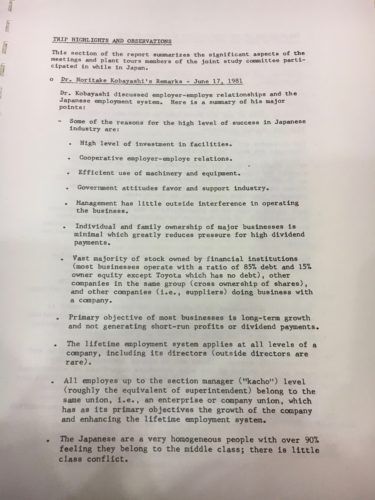
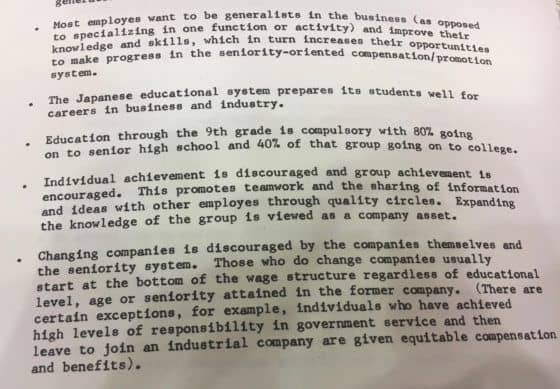
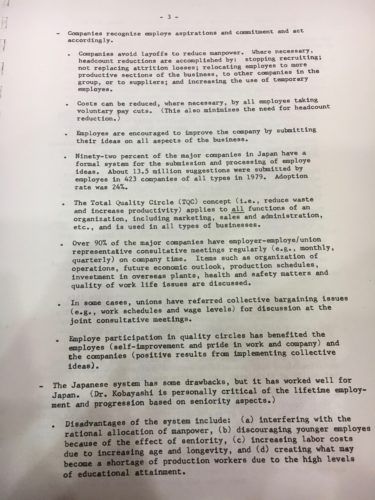
What stands out from a Lean perspective?
From the first page:
“Cooperative employer-employe relations”
And
“Primary objective of most businesses is long-term growth and not generating short-run profits or dividend payments.”
There is a reason that Point Number 1 of The Toyota Way (as distilled by Prof. Jeff Liker) says:
“Base your management decisions on a long-term philosophy, even at the expense of short-term financial goals.”
For all of the organizations that say they are “implementing Lean,” how many of them have executives focusing more on the long term? Is the lack of fidelity to POINT NUMBER 1 on the list a reason for the high rate of “Lean failures?” Seems like it.
As Dr. Deming would have said, the elements of The Toyota Way are a system. Toyota, today, describes their approach as “an integrated system.” Why would you expect to be able to cherry pick bits and pieces and be as successful?
When people tour Japan, in 1981 or today, there's a risk that people just see tools and tactics to copy, instead of seeing a system.
Back to Kobayashi's points:
“Individual achievement is discouraged and group achievement is encouraged. This promotes teamwork and the sharing of information and ideas with other employees through quality circles. Expanding the knowledge of the group is viewed as a company asset.”
American culture is considered to be much more individualistic. But, I've seen leaders create an environment where people work and learn and share in teams (come see this at Franciscan in May).
Kobayashi adds other factors that led to success:
“Companies avoid layoffs to reduce manpower. Where necessary, headcount reductions are accomplished by: stopping recruiting; not replacing attrition losses; relocating employees to more productive sections of the business… and increasing the use of temporary employes.”
A major barrier to Lean success is companies and health systems today that focus too much on cost cutting (as is their old habit) and rely on layoffs for cost cutting.
The most successful Lean organizations today make a similar commitment to their employees, as I've written about before (and blogged about, including here and here).
An old lesson from 1981, again, is really relevant today.
It also says:
“Costs can be reduced, where necessary, by all employes taking voluntary pay cuts.”
I wouldn't suggest that today, unless it was a dire emergency. In Japan, as I learned in my 2012 visit, organizations start the pay cuts at THE TOP. Executives take pay cuts first and then, if necessary, things cascade down to the front line. When times get better, the pay increases happen in reverse… frontline employees first and executives last.
It's more common in the U.S. and other countries for executives to slash worker pay and maintain their own pay (if not giving themselves big bonuses for “cutting costs”).
Kobayashi also said:
“Employees are encouraged to improve the company by submitting their ideas on all aspects of the business.”
That's the Kaizen model of continuous improvement, which is very different than the old fashioned suggestion box system we still had at GM in 1997. Some companies and healthcare system have that culture of Kaizen today… but we need more of it.
“92% of the major companies in Japan have a formal system for the submission and processing of employe ideas. About 13.5 million suggestions were submitted by employes in 423 companies of all types in 1979. Adoption rate was 24%.”
I think this goes to show that not all idea / Kaizen / suggestion systems are created equal. The benchmark at Toyota is said to be about 90% implementation rates for ideas (read my post about a Toyota tour guide implementing her idea).
Franciscan St. Francis Health has similar rates in some of their sites and departments.
Update: Deeper in the document, there are some numbers about Toyota's Kaizen approach:

Toyota had a 94% adoption rate, not surprising.
Some of our KaiNexus customers are also at that 90+ rate and, across all of our customers, the adoption rate is about 75%.
That's because a Kaizen process keeps decision making in the hands of local teams, most of the time. It's not about “processing” ideas and submitting them all upward. That's a suggestion box or “ideation” process that usually leads to just 2% or 3% implementation rates, at best.
I bet some of the Japanese companies in 1981 still had what was basically a suggestion box process. Toyota is not the same as all Japanese companies.
It also said:
“Total Quality Circle (TQC) concept (i.e., reduce waste and increase productivity) applies [to] all functions of an organization, including marketing, sales and administration, etc., and is used in all types of businesses.”
As I saw, TQM and quality circles are still active in Japan today.
There's a good Lean lesson there, again, about applying these methods to all types of businesses and all parts of the organization.
Kobayashi also added:
“Employe participation in quality circles has benefited the employes (self-improvement and pride in work and company) and the companies (positive results from implementing collective ideas.”
We see this in great Lean or Kaizen cultures, including at Franciscan St. Francis. There's mutual benefit to participating in improvement. It becomes addictive (see these videos)… people start doing Kaizen at home (as we wrote about in chapter 12 of Healthcare Kaizen) because it's their CHOICE.

It's always a choice to participate in Lean or Kaizen. Smart leaders create an environment that encourages people to participate rather than forcing them to do so.
I'll continue going through this Ford / UAW document in future posts.
One other point from that part of the document said:
“… belief that the Japanese auto manufacturers cannot continue to export finished units without establishing production facilities overseas.”
This was a few years before GM and Toyota signed their joint venture agreement for the NUMMI plant (something that Ephlin was directly involved in and I'll blog about more) and before Toyota opened their Georgetown, Kentucky site.
An earlier post in this Don Ephlin series:
I think it's all very interesting history… but, more importantly, I think these points from 1981 are pretty relevant today, on many levels.
What do you think?
What do you think? Please scroll down (or click) to post a comment. Or please share the post with your thoughts on LinkedIn – and follow me or connect with me there.
Did you like this post? Make sure you don't miss a post or podcast — Subscribe to get notified about posts via email daily or weekly.
Check out my latest book, The Mistakes That Make Us: Cultivating a Culture of Learning and Innovation:











I often see comments about when a particular Toyota plant started operating (e.g., 1965 above). Is that far longer than American plants? Can you give some context?
Thanks.
Sure… you can see a list of GM factories here, for example.
GM Flint Truck assembly dates back to 1947, for example.
Hi Mark! Great article!! Is the full 1981 Ford/UAW report available to the public somewhere I could access? And do you think that Japanese companies (or just Toyota) still operate under the same ideals today? What is your opinion on teamwork vs group-thinking? Do you think individualism can be a good thing, as far as innovation and competition? Is one better than the other for a company to be successful? Thank you so much!! ~Van
Hi Van –
Thanks for your comment. It’s available physically at the Wayne State library:
http://reuther.wayne.edu/taxonomy/term/1468
I think you can make a request for the file online.
I don’t know if I really have the current-day answers to your questions.
I think Lean and continuous improvement are about teamwork. Improvement might start with an individual speaking up to point out a problem or having an idea… but most every improvement is going to involve team members. Americans like being part of teams… I don’t think we’re quite as individualistic as the stereotype would say.
Mark